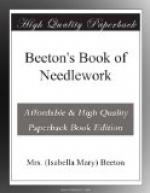This square is worked in the so-called point de Venise, together with other squares; it is very pretty for covers, toilet cushions, &c. It is worked on coarse or fine linen, according to the use you wish to make of it. Prepare a square piece of linen, by drawing out long and cross threads, so as to form perfect squares. In the pattern No. 540, which is worked on fine linen, 28 threads have been drawn out, both the long and cross way; 8 squares are formed in this way each time that 28 threads have been drawn out; leave 7 or 8 threads of the ground, which form the framework. Then fasten the piece of linen on cardboard, and work close button-hole stitch round the inner edge Then work with darning stitch over the long and cross threads of the ground.
From No. 541, which shows the fourth part of the square 4 times larger than full size, it is easy to see how the framework is darned. When the latter is entirely darned, work the patterns in the different squares in button-hole stitch. The circular and serpentine patterns consist of 3 rows of button-hole stitch; the patterns which imitate whole rosettes and half rosettes are worked in rows of button-hole stitch. For each row the thread must be first drawn from one place to the other, as can be seen in illustration, and fastened on the framework. The knots in the last button-hole stitched row are made by working in each stitch when completed, another stitch, and drawing the cotton again through the first completed knot. It is easy, however, to work all the patterns from No. 541. The dotted lines in the right-hand corner show the direction of the patterns which are wanting there. The square is edged all round with an open-work hem, which can also be worked from No. 541.
* * * * *
542 and 543.—Corner Patterns in Guipure d’Art.
Material: Messrs. Walter Evans and Co.’s Mecklenburg thread No. 14.
These patterns are very pretty for cushions, handkerchiefs, &c. The netted ground is to be worked from the corner. Cast on 2 stitches, and work in rows backwards and forwards, increasing 1 stitch at the end of every row. The pattern is worked in point d’esprit, linen, and darning stitch, as can be seen in illustration.
[Illustration: 542 and 543—Corner Borders.]
* * * * *
544.—Flower for Ornamenting Cravats and Caps in Guipure d’Art.
Materials: Black or coloured silks, or Messrs. Walter Evans and Co.’s Mecklenburg thread No. 10.
[Illustration: 544.—Flower in Guipure d’Art.]
This pattern is worked with middle-sized light-coloured purse silk in guipure d’art on netting. This pattern can also be worked with white thread or black silk in point de reprise.
* * * * *
545.—Work Basket with Covering of Darned Netting.
Materials: Bamboo cane basket; blue satin; cardboard;
netting; Messrs.
Walter Evans and Co’s Mecklenburg thread No.
16.




